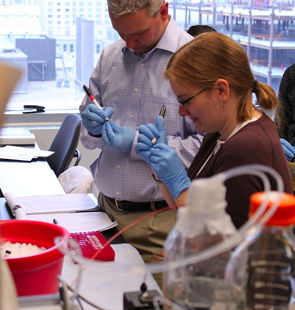Science textbooks might be gathering dust in some classrooms across the country, but that doesn't mean students aren't learning. Whether it's determining if cell phone radiation is harmful or it's using the premise of Space Invaders to calculate probabilities, some lucky students are using the latest high tech to learn science and theories.
As the public school infrastructure sorts out how informal learning through technology is going to fit into the system, individual teachers, principals, administrators, and education professionals are taking initiative to engage students in science, math, engineering and technology.
They gathered over the last two days at the Cyberlearning Tools for STEM Education conference to share their ideas and to inspire each other.
Here are just a few of the fascinating science, math, and tech experiments that bring concepts to life. Adapted from the CYTSE program.
- STATS INVADERS! GAME PLAY AS HOMEWORK. A computer game called Stats Invaders (modeled on the classic arcade game Space Invaders) gives players basic intuitions about both sampling from probability distributions and the statistical hypothesis-testing process. Educator Dylan Arena of Stanford uses these intuitions in his formal instruction. In the game, players must shoot descending aliens according to one of two probability distributions, then decide which distribution the aliens are following. The effectiveness of the game was demonstrated in a previous laboratory study. in collaboration with Dan Schwartz and Lee Martin at U.C. Davis.
- PHYSICS SIMULATIONS CREATE ANIMATED ENVIRONMENTS. Educator Patricia Loblein from Evergreen High School integrates interactive simulations into high school physics and chemistry. The PhET Project has developed more than 90 simulations for teaching and learning introductory physics, chemistry, biology and earth sciences. These research-based simulations create animated, interactive, game-like environments designed to engage students in active thinking, encourage experimentation, and help develop visual and conceptual models of physical phenomena, emphasizing their connections to everyday life. With their flexible, open-exploratory nature, these simulations are commonly used from middle school through college level teaching. Best of all, they're free, and can be run from the PhET website.
- MOBILE APP TEACHES BIODIVERSITY. Green Hat & Engineering Pathway is an interactive mobile learning app that helps students learn about biodiversity and sustainability issues in their surroundings from experts’ points of view, before participating in unfamiliar debates about their familiar surroundings. Using the interactive location-sensitive map and video on a smart phone, GreenHat simulates how experts go about making observations in the field and encourages students to actively observe their environment. GreenHat uses infrastructure from Engineering Pathway, a K-Gray engineering education digital library, in how it searches, organizes, and curates learning resources in a mobile context. Presented by Alice Agogino, U.C. Berkeley, Kimiko Ryokai and Lora Oehlberg.
- CONDUCTING RESEARCH THROUGH VIRTUAL LABS. High school students using the iLab Network (based at Northwestern University) access real instruments remotely using their web browser. Both the Radioactivity iLab and ICP-OES iLab provide students with the opportunity to collect and analyze real data using the multiple steps of the scientific method. Students integrate conventional chemistry, physics, biology, and environmental science concepts with experiments using high-end lab equipment that's traditionally too costly for high schools to purchase. Check out the video below that describes the program.


